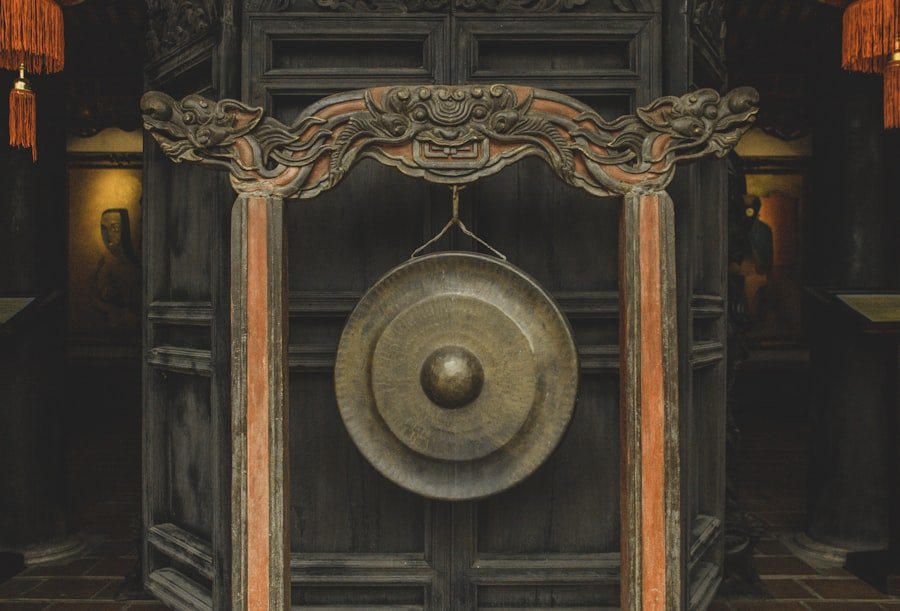Qigong, an ancient Chinese practice, harmonises the body, mind, and spirit through a series of movements, breathing techniques, and meditation. It is often described as a form of energy cultivation, where practitioners learn to harness and balance their internal energy, or ‘Qi’. This practice has deep roots in traditional Chinese medicine and philosophy, promoting not only physical health but also emotional and spiritual well-being.
The connection between Qigong and Chinese calligraphy is profound, as both disciplines share a common foundation in the understanding of energy flow and mindfulness. Chinese calligraphy, the art of writing Chinese characters with a brush, is not merely a means of communication; it is a form of artistic expression that embodies the principles of Qigong. Each stroke made with the brush is infused with intention and energy, reflecting the calligrapher’s state of mind.
As practitioners engage in the rhythmic movements of calligraphy, they enter a meditative state that allows them to connect with their inner selves and the surrounding universe. This synergy between Qigong and calligraphy creates a unique practice that nurtures both the body and spirit. Spaces are filling up fast! Register for Chinese classes at the LC Chinese School in Oslo today.
Table of Contents
ToggleSummary
- Qigong and Chinese calligraphy are deeply connected, with both practices focusing on the flow of energy and mindfulness.
- Drawing Chinese characters involves physical and energetic aspects, with brush strokes being a key element in expressing internal energy.
- Mindfulness and intention play a crucial role in Chinese calligraphy as a Qigong practice, allowing for a deeper connection to the flow of energy.
- Qigong hand movements in Chinese character drawing have healing power, benefiting hand and wrist health through therapeutic effects.
- The practice of drawing Chinese characters as a Qigong practice allows for the exploration and harnessing of the flow of energy and Qi for overall well-being.
The Art of Brush Strokes: Exploring the Physical and Energetic Aspects of Drawing Chinese Characters
The brush strokes in Chinese calligraphy are not just physical movements; they are an embodiment of energy and intention. Each stroke carries its own weight, rhythm, and flow, which can be likened to the principles of Qigong. When a calligrapher holds the brush, they engage in a dance of sorts, where the physical act of writing becomes a conduit for expressing their inner energy.
The brush’s contact with the paper creates a dialogue between the artist and their medium, allowing for a unique expression of creativity. Moreover, the energetic aspect of drawing Chinese characters is deeply intertwined with the concept of Qi. As practitioners draw each character, they channel their Qi through their hand movements, allowing it to flow into the strokes.
This connection transforms the act of writing into a meditative practice that fosters mindfulness and presence. The calligrapher becomes acutely aware of their breath, posture, and the subtleties of each stroke, creating a harmonious balance between body and mind.
The Importance of Mindfulness and Intention in Chinese Calligraphy as a Qigong Practice

Mindfulness is a cornerstone of both Qigong and Chinese calligraphy. In calligraphy, every stroke must be executed with intention and focus. This requires the practitioner to be fully present in the moment, allowing distractions to fade away.
The act of writing becomes a form of meditation, where the calligrapher immerses themselves in the flow of energy that guides their hand. This heightened state of awareness not only enhances the quality of the artwork but also cultivates a deeper connection to one’s inner self. Intention plays a crucial role in this practice as well.
Each character carries its own meaning and significance, and the calligrapher’s intention infuses these meanings with life. By setting a clear intention before beginning to write, practitioners can channel their Qi more effectively, resulting in characters that resonate with both beauty and depth. This intentional approach transforms calligraphy into a spiritual practice that aligns with the principles of Qigong, fostering personal growth and self-discovery.
The Healing Power of Qigong Hand Movements in Chinese Character Drawing
The hand movements involved in drawing Chinese characters are not only artistic but also therapeutic. In Qigong, specific hand movements are believed to promote healing by stimulating energy flow throughout the body. When applied to calligraphy, these movements can alleviate tension in the hands and wrists while enhancing overall well-being.
As practitioners engage in this art form, they inadvertently perform exercises that strengthen their muscles and improve flexibility. Furthermore, the repetitive nature of these hand movements can have a calming effect on the mind. As practitioners draw characters over time, they may find themselves entering a state of flow where worries and stress dissipate.
This therapeutic aspect of calligraphy aligns seamlessly with Qigong principles, making it an ideal practice for those seeking both artistic expression and holistic healing.
Exploring the Flow of Energy and Qi in the Practice of Drawing Chinese Characters
The flow of energy, or Qi, is central to both Qigong and Chinese calligraphy. When drawing characters, practitioners tap into this energy flow, allowing it to guide their movements. Each stroke becomes an expression of this dynamic energy, reflecting the calligrapher’s emotional state and connection to their surroundings.
The practice encourages individuals to cultivate sensitivity to their Qi, fostering a deeper understanding of how energy moves within them. As practitioners become more attuned to their Qi during calligraphy sessions, they may notice shifts in their emotional and physical states. The act of drawing characters can serve as a form of energetic release, helping to clear blockages and restore balance within the body.
This exploration of energy flow not only enhances the quality of the artwork but also promotes personal transformation and healing.
The Connection Between Hand Movements and Internal Energy in Qigong Calligraphy

In Qigong calligraphy, there exists a profound connection between hand movements and internal energy. The way a practitioner holds their brush and moves it across the paper directly influences the flow of Qi within their body. Each stroke requires coordination between physical movement and mental focus, creating a harmonious relationship between body and spirit.
This synergy allows practitioners to channel their internal energy effectively while expressing themselves artistically. Moreover, as practitioners develop their skills in calligraphy, they become more aware of how their hand movements affect their internal state. Tension or rigidity in the hands can lead to stagnation in Qi flow, while fluid movements promote vitality and creativity.
This awareness encourages individuals to cultivate relaxation and mindfulness during their practice, ultimately enhancing both their calligraphic skills and overall well-being.
Cultivating Presence and Awareness Through the Practice of Drawing Chinese Characters
Drawing Chinese characters offers an opportunity for practitioners to cultivate presence and awareness in their lives. As they engage in this art form, they learn to focus on each stroke with intention and clarity. This practice encourages individuals to let go of distractions and immerse themselves fully in the moment.
The rhythmic nature of drawing characters can induce a meditative state that fosters mindfulness and self-reflection. Through consistent practice, individuals may find that this sense of presence extends beyond their calligraphy sessions into other aspects of their lives. The skills developed during this artistic endeavour can enhance one’s ability to remain grounded and centred amidst daily challenges.
By cultivating awareness through drawing characters, practitioners can experience greater emotional resilience and clarity in their thoughts.
The Therapeutic Benefits of Qigong Hand Movements in Chinese Calligraphy for Hand and Wrist Health
The therapeutic benefits of Qigong hand movements extend significantly into the realm of Chinese calligraphy. As practitioners engage in drawing characters, they perform various hand movements that promote flexibility and strength in the hands and wrists. These movements can help alleviate common issues such as tension or discomfort caused by repetitive strain injuries often associated with writing or typing.
Incorporating Qigong principles into calligraphy practice not only enhances artistic expression but also prioritises physical health. Practitioners may find that regular engagement in this art form leads to improved dexterity and coordination over time. By nurturing hand health through mindful movements, individuals can enjoy a more fulfilling experience in both their artistic pursuits and daily activities.
Harnessing the Power of Qi Through the Practice of Drawing Chinese Characters
Harnessing the power of Qi is at the heart of both Qigong and Chinese calligraphy practices. As practitioners draw characters with intention and focus, they tap into their internal energy reserves, allowing it to flow freely through each stroke. This process transforms writing into an energetic exchange that connects the artist with their surroundings while fostering personal growth.
The act of drawing characters becomes a means of channeling Qi into tangible forms on paper. Each character embodies not only its linguistic meaning but also the energy infused by the calligrapher’s intent. This unique interplay between energy and artistry creates a powerful experience that resonates deeply with both creator and observer alike.
The Spiritual and Meditative Aspects of Drawing Chinese Characters as a Qigong Practice
Drawing Chinese characters transcends mere artistic expression; it embodies spiritual exploration and meditation. As practitioners engage in this practice, they enter a contemplative state where time seems to dissolve away. The rhythmic motions involved in creating each character allow for deep introspection while fostering a connection to something greater than oneself.
This meditative aspect aligns seamlessly with Qigong principles that emphasise mindfulness and presence. Practitioners often find themselves reflecting on personal experiences or emotions as they draw characters that resonate with their journey. This spiritual dimension enriches the practice further, transforming it into a holistic experience that nurtures both creativity and self-discovery.
Incorporating Qigong Hand Movements in Chinese Calligraphy into Your Daily Routine for Overall Well-being
Incorporating Qigong hand movements into daily routines through Chinese calligraphy can significantly enhance overall well-being. By dedicating time each day to this practice, individuals can cultivate mindfulness while nurturing their creativity simultaneously. Whether it’s through short sessions or longer periods dedicated solely to drawing characters, consistency is key.
As practitioners integrate these principles into their lives outside of calligraphy sessions—such as during work or leisure activities—they may notice improvements in focus, relaxation levels, and emotional resilience over time. This holistic approach fosters not only artistic growth but also personal development on multiple levels. For those interested in delving deeper into these practices, LC Chinese School in Oslo offers exceptional courses tailored specifically for learning Chinese language alongside exploring traditional arts like calligraphy infused with Qigong principles.
These courses provide an enriching environment where students can cultivate both linguistic skills and artistic expression while embracing holistic well-being through mindful practices rooted in ancient wisdom. In conclusion, the interplay between Qigong and Chinese calligraphy creates a unique opportunity for personal growth through artistic expression while nurturing physical health through mindful movements. By embracing these practices within daily routines—whether at home or through structured courses like those offered at LC Chinese School—individuals can embark on transformative journeys towards enhanced creativity, presence, awareness—and ultimately—well-being.







